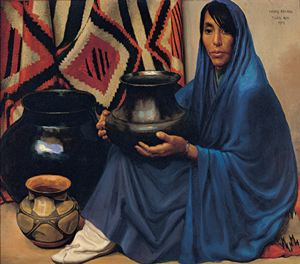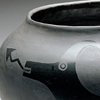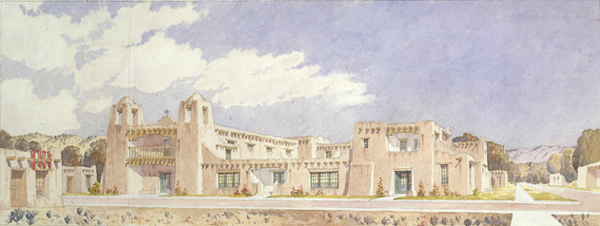Edgar L. Hewett created thefirst art museum in New Mexico in 1917. Hewett was an anthropologist, teacher and administrator who played a pivotal role in turning Santa Fe into a center for art and anthropological research. After New Mexico became a state in 1912, Hewett created an economic plan based on developing cultural institutions and promoting the unique, indigenous qualities of Southwestern arts. After holding art exhibitions in the hi storic Palace of the Governors, Hewett’s Pueblo Spanish revival style art museum opened in 1917. As director, Hewett was committed to exhibiting work that mixed anthropology with art, such as Henry Balink’s painting Pueblo Pottery. Hewett was also committed to an “open door approach”, a policy promoted by the artist Robert Henri, which allowed any artist working in New Mexico to exhibit at the museum. This was a radical approach created in opposition to the exclusive academies that recognized only European academic art.
storic Palace of the Governors, Hewett’s Pueblo Spanish revival style art museum opened in 1917. As director, Hewett was committed to exhibiting work that mixed anthropology with art, such as Henry Balink’s painting Pueblo Pottery. Hewett was also committed to an “open door approach”, a policy promoted by the artist Robert Henri, which allowed any artist working in New Mexico to exhibit at the museum. This was a radical approach created in opposition to the exclusive academies that recognized only European academic art.
 Hewett was also the director of the School for American Research, and as an anthropologist he was very involved with Native American artists . He created the “Santa Fe Program” initially to encourage potters from San Idelfonso to improve their wares. He lucked out by meeting Maria Martinez and her husband Julian, who became masters of their medium and invented the elegant, matte black and polished black pottery that became world renown. Hewett and his partner Kenneth Chapman worked with other Pueblo potters and encouraged the revival of ancient designs that were found on excavated pottery and petroglyphs throughout the Southwest.
Hewett was also the director of the School for American Research, and as an anthropologist he was very involved with Native American artists . He created the “Santa Fe Program” initially to encourage potters from San Idelfonso to improve their wares. He lucked out by meeting Maria Martinez and her husband Julian, who became masters of their medium and invented the elegant, matte black and polished black pottery that became world renown. Hewett and his partner Kenneth Chapman worked with other Pueblo potters and encouraged the revival of ancient designs that were found on excavated pottery and petroglyphs throughout the Southwest.
San Idelfonso day school teachers were influenced by the Santa Fe program and began a controversial project encouraging Native American students to draw pictures form their own experiences. At this time the Dawes Act supported the assimilation of native students into the mainstream society, and did not permit federal Indian School students to acknowledge their own traditions and lifestyles, or to speak their native languages. Students like Alfred Montoya continued the practice regardless, and pueblo easel painting was incorporated into the Santa Fe Program. In later years, Hewett would exhibit Pueblo easel paintings at the museum, and the artwork was highly appreciated by the local art community.

